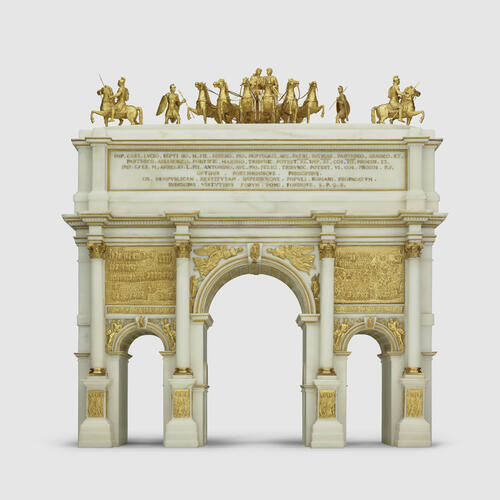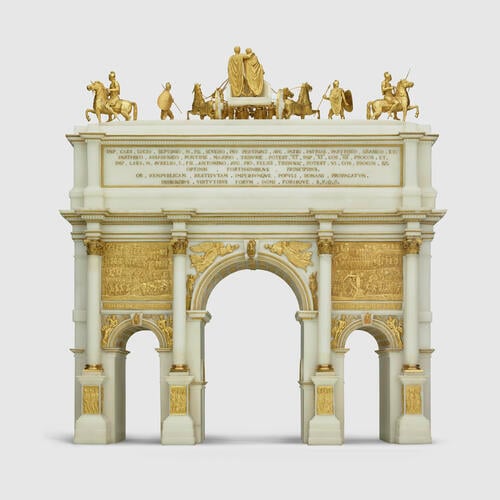-
1 of 253523 objects
Arch of Septimius Severus c.1808-15
Marble and gilt bronze | 63 x 57 x 27.5 cm (whole object) | RCIN 43916
-
George IV never experienced what had become a standard component of the education of English gentlemen of his generation, the Grand Tour to Italy, of which the culmination was invariably Rome. Here, in the Forum, at that time an only partly excavated field known as the Campo Vaccino, the English milordi were shown the three partly ruined triumphal arches set up by the Emperors Titus (erected on the summit of the Velia overlooking the Forum in AD 81), Septimius Severus (erected in AD 203 in honour of the Emperor and his sons Caracalla and Geta) and Constantine (built to commemorate his victory over Maxentius in AD 312). Models of the arches in their semi-ruined condition (often effectively imitated in cork) were among the souvenirs with which the tourists returned to England. However, these marble models are reconstructions of the original form of the arches, complete with figurative sculpture. This model of Septimius Severus together with those of Titus and Constantine were made under the auspices of the Roman Academy of St Luke by the silversmiths Giovacchino Belli and his son Pietro. Pietro Santi Ammendola, who also signed all three arches, was a Roman merchant who probably financed the Bellis during their seven-year task. In a printed description of the arches published in 1815, the secretary of the Academy of St Luke, Giuseppe Antonio Guattani, praised the artists for their 'seraphic patience'. This publication, which is tantamount to a sale brochure, ends with a testimonial from the Perpetual Principal of the Academy, Antonio Canova, praising the 'genius, accuracy and infinite precision' of the models. This was not unjustified; more than a thousand individual gilt bronze plaques in various sizes were used to ornament the vaults of the Arch of Septimius Severus, which are largely invisible in normal circumstances. In the course of his description, Guattani suggested that no ornaments more beautiful than these models could be found 'for the tables of the Great or the cabinets of Princes'. In view of the recent defeat and exile of Napoleon, to whom this comment might formerly have been directed, Ammendola brought the completed models to London where, according to Joseph Farington, they were offered to George IV for 3,000 guineas on 10 November 1816. The price was eventually reduced to 500 guineas, the sum recorded by Benjamin Jutsham in his Day Book for 8 November. The arches were placed on Boulle pedestals in the window reveals of the library at Carlton House, where they were noticed by Pyne as 'most ingenious specimens of sculpture in miniature'. Certain repairs to the metalwork were undertaken by Charles Brandt in January 1818, and later the same year B.L. Vulliamy replaced some of the ornaments, apparently in silver gilt, and made glass covers for the three arches. Following the demolition of Carlton House in 1826 the models were taken to Buckingham Palace; they were subsequently transferred to Windsor Castle, where they can be seen in Joseph Nash's watercolour of the Grand Corridor. Catalogue entry from Royal Treasures, A Golden Jubilee Celebration, London 2002
Provenance
Bought, together with two further arches, by George IV from Pietro Santi Ammendola of Rome, November 1816 (500 guineas).
Included in the Pictorial Inventory of 1827-33 – RCIN 934840. The inventory was originally created as a record of the clocks, vases, candelabra and other miscellaneous items from Carlton House, as well as selected items from the stores at Buckingham House, the Royal Pavilion, Brighton, Hampton Court and Kensington Palace for consideration in the refurbishment of Windsor Castle.
-
Creator(s)
(retailer/supplier)Acquirer(s)
-
Medium and techniques
Marble and gilt bronze
Measurements
63 x 57 x 27.5 cm (whole object)
Category
Object type(s)


